Introduction
Welcome, intrepid explorers, to the ultimate guide for your Himalayan adventures! Within these pages, you’ll discover a world of breathtaking vistas, challenging trails, and unforgettable experiences. From the snow-capped peaks of Kedarkantha to the frozen rivers of Chadar, each trek offers a unique journey into the heart of the world’s most majestic mountain range.
Whether you’re a seasoned trekker or a novice adventurer, this guide will provide you with detailed itineraries, invaluable insights, and a taste of the wonders that await you in the Himalayas. So lace up your boots, pack your sense of wonder, and let’s embark on a journey of a lifetime!
Table of Contents
-
Kedarkantha Trek: A Winter Wonderland
-
Brahmatal Trek: Lakes, Peaks, and Panoramas
-
Dayara Bugyal Trek: Meadows in the Sky
-
Kuari Pass Trek: The Lord Curzon Trail
-
Skiing in Gulmarg: Powdery Paradise
-
Chadar Trek: Walking on Frozen Dreams
-
Nag Tibba Trek: The Serpent’s Peak
-
Har Ki Dun Trek: Valley of the Gods
Kedarkantha Trek: A Winter Wonderland
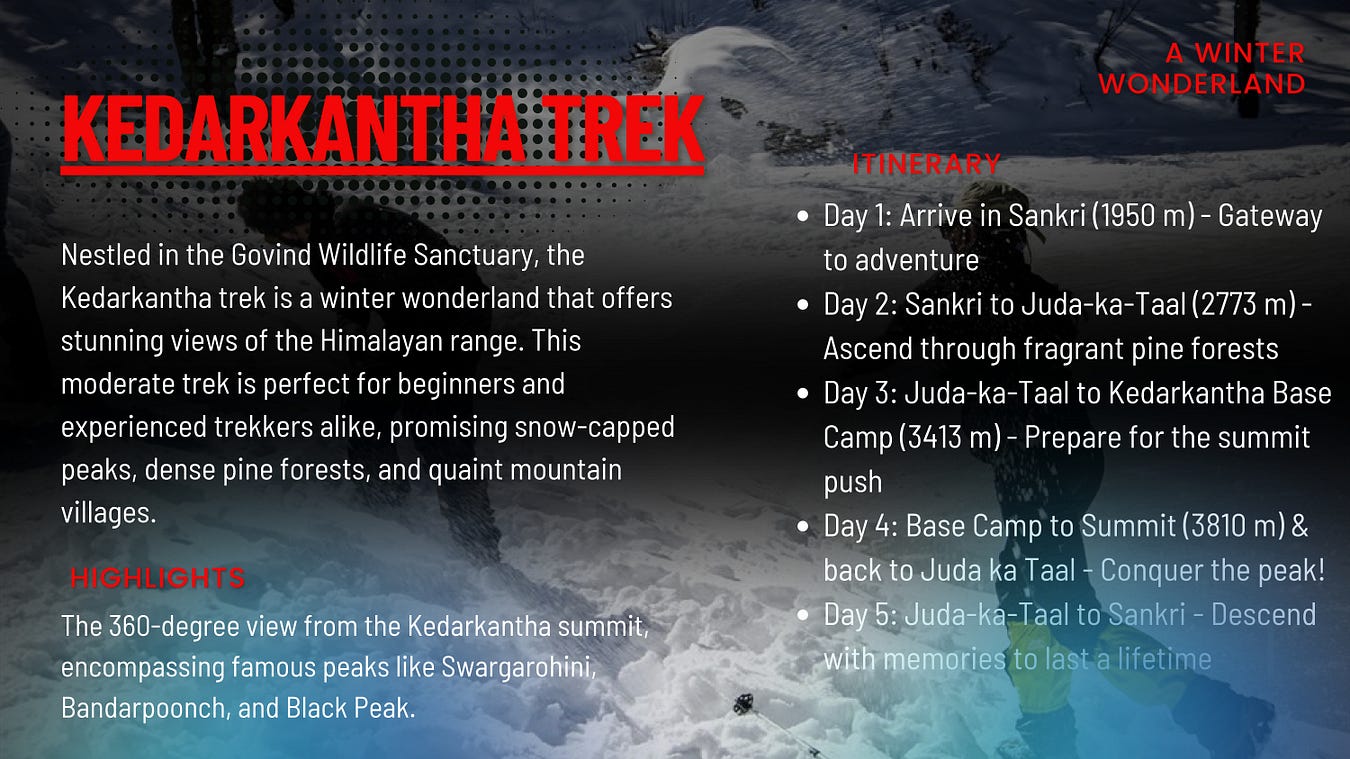 Kedarkantha Trek: Brief
Kedarkantha Trek: Brief
Nestled in the Govind Wildlife Sanctuary, the Kedarkantha trek is a winter wonderland that offers stunning views of the Himalayan range. This moderate trek is perfect for beginners and experienced trekkers alike, promising snow-capped peaks, dense pine forests, and quaint mountain villages.
Itinerary
-
Day 1: Arrive in Sankri (1950 m) — Gateway to adventure
-
Day 2: Sankri to Juda-ka-Taal (2773 m) — Ascend through fragrant pine forests
-
Day 3: Juda-ka-Taal to Kedarkantha Base Camp (3413 m) — Prepare for the summit push
-
Day 4: Base Camp to Summit (3810 m) & back to Juda ka Taal — Conquer the peak!
-
Day 5: Juda-ka-Taal to Sankri — Descend with memories to last a lifetime
💡 Highlight: The 360-degree view from the Kedarkantha summit, encompassing famous peaks like Swargarohini, Bandarpoonch, and Black Peak.
Brahmatal Trek: Lakes, Peaks, and Panoramas
 Brahmatal Trek: Brief
Brahmatal Trek: Brief
The Brahmatal trek is a hidden gem in the Uttarakhand Himalayas, offering a perfect blend of pristine lakes, dense forests, and panoramic mountain views. This moderate trek is ideal for those seeking solitude and natural beauty.
Brief Itinerary
-
Day 1: Arrive at Lohajung (2331 m) — Begin your Himalayan journey
-
Day 2: Lohajung to Gujreni/Lower Bekaltal (2750 m) — Trek through rhododendron forests
-
Day 3: Gujreni to Brahmatal (3400 m) — Ascend to the mystical lake
-
Day 4: Brahmatal to Brahmatal Top (3846 m) and back — Experience breathtaking views
-
Day 5: Brahmatal to Lohajung — Descend through picturesque landscapes
-
Day 6: Departure from Lohajung — Bid farewell to the mountains
💡 Highlight: The mesmerizing reflection of Mt. Trishul and Mt. Nanda Ghunti in the crystal-clear waters of Brahmatal.
Dayara Bugyal Trek: Meadows in the Sky
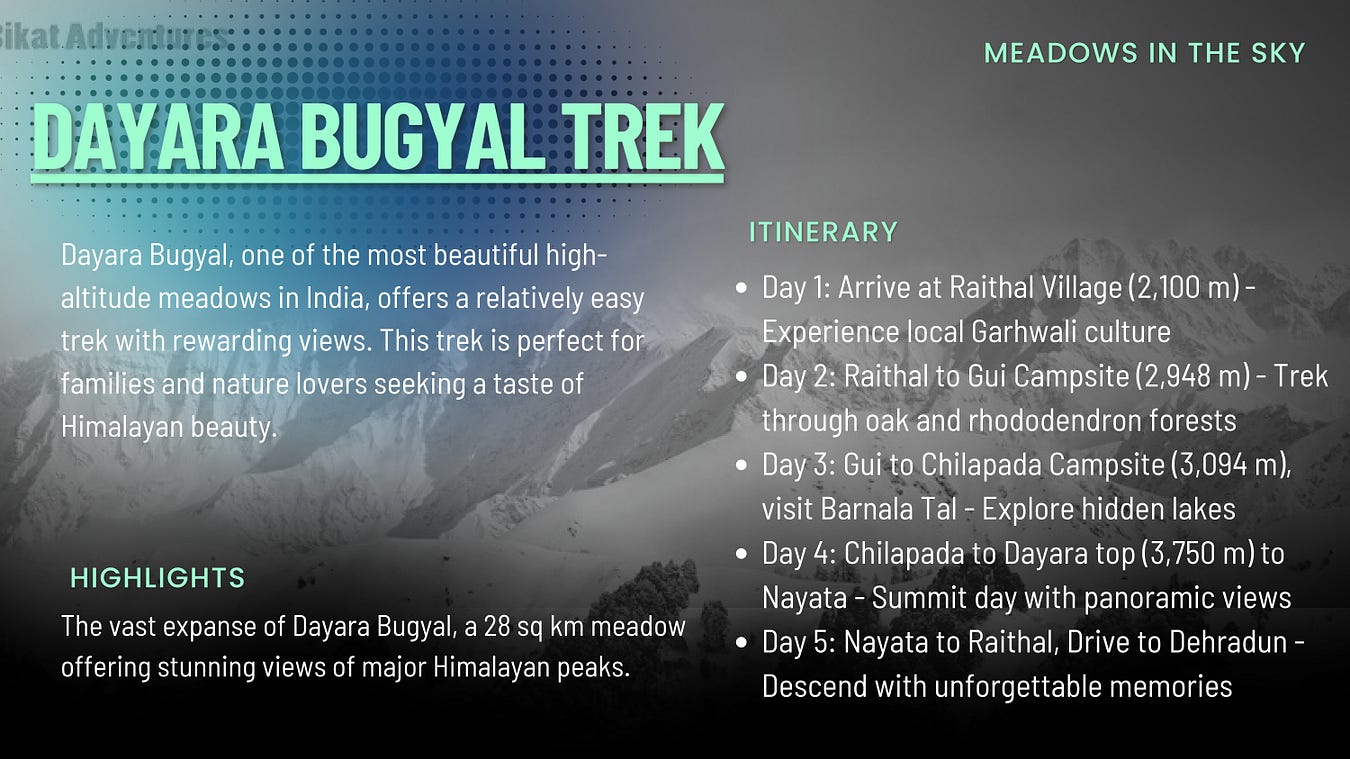
Dayara Bugyal Trek , one of the most beautiful high-altitude meadows in India, offers a relatively easy trek with rewarding views. This trek is perfect for families and nature lovers seeking a taste of Himalayan beauty.
Itinerary
-
Day 1: Arrive at Raithal Village (2,100 m) — Experience local Garhwali culture
-
Day 2: Raithal to Gui Campsite (2,948 m) — Trek through oak and rhododendron forests
-
Day 3: Gui to Chilapada Campsite (3,094 m), visit Barnala Tal — Explore hidden lakes
-
Day 4: Chilapada to Dayara top (3,750 m) to Nayata — Summit day with panoramic views
-
Day 5: Nayata to Raithal, Drive to Dehradun — Descend with unforgettable memories
💡 Highlight: The vast expanse of Dayara Bugyal, a 28 sq km meadow offering stunning views of major Himalayan peaks.
Kuari Pass Trek: The Lord Curzon Trail
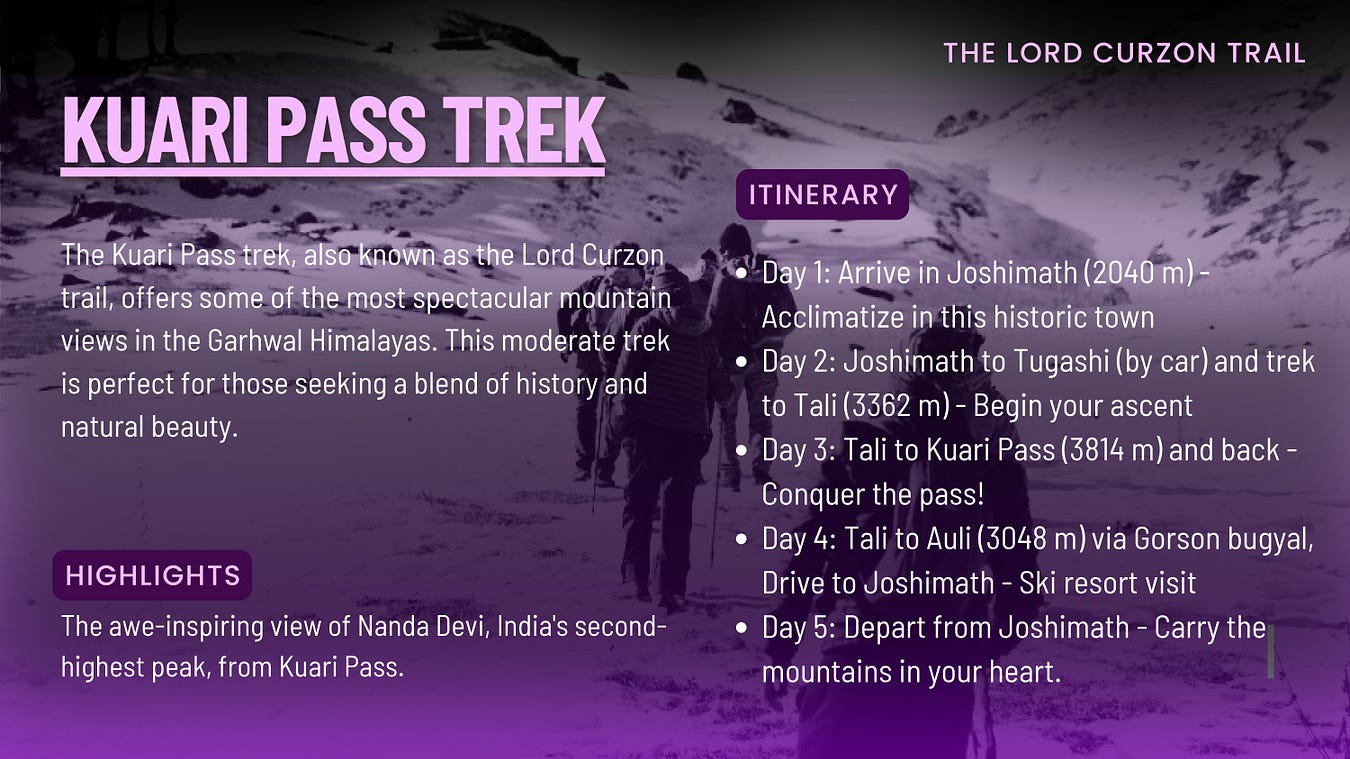 Kuari Pass Trek
Kuari Pass Trek
The Kuari Pass trek, also known as the Lord Curzon trail, offers some of the most spectacular mountain views in the Garhwal Himalayas. This moderate trek is perfect for those seeking a blend of history and natural beauty.
Itinerary
-
Day 1: Arrive in Joshimath (2040 m) — Acclimatize in this historic town
-
Day 2: Joshimath to Tugashi (by car) and trek to Tali (3362 m) — Begin your ascent
-
Day 3: Tali to Kuari Pass (3814 m) and back — Conquer the pass!
-
Day 4: Tali to Auli (3048 m) via Gorson bugyal, Drive to Joshimath — Ski resort visit
-
Day 5: Depart from Joshimath — Carry the mountains in your heart
💡 Highlight: The awe-inspiring view of Nanda Devi, India’s second-highest peak, from Kuari Pass.
Skiing in Gulmarg: Powdery Paradise
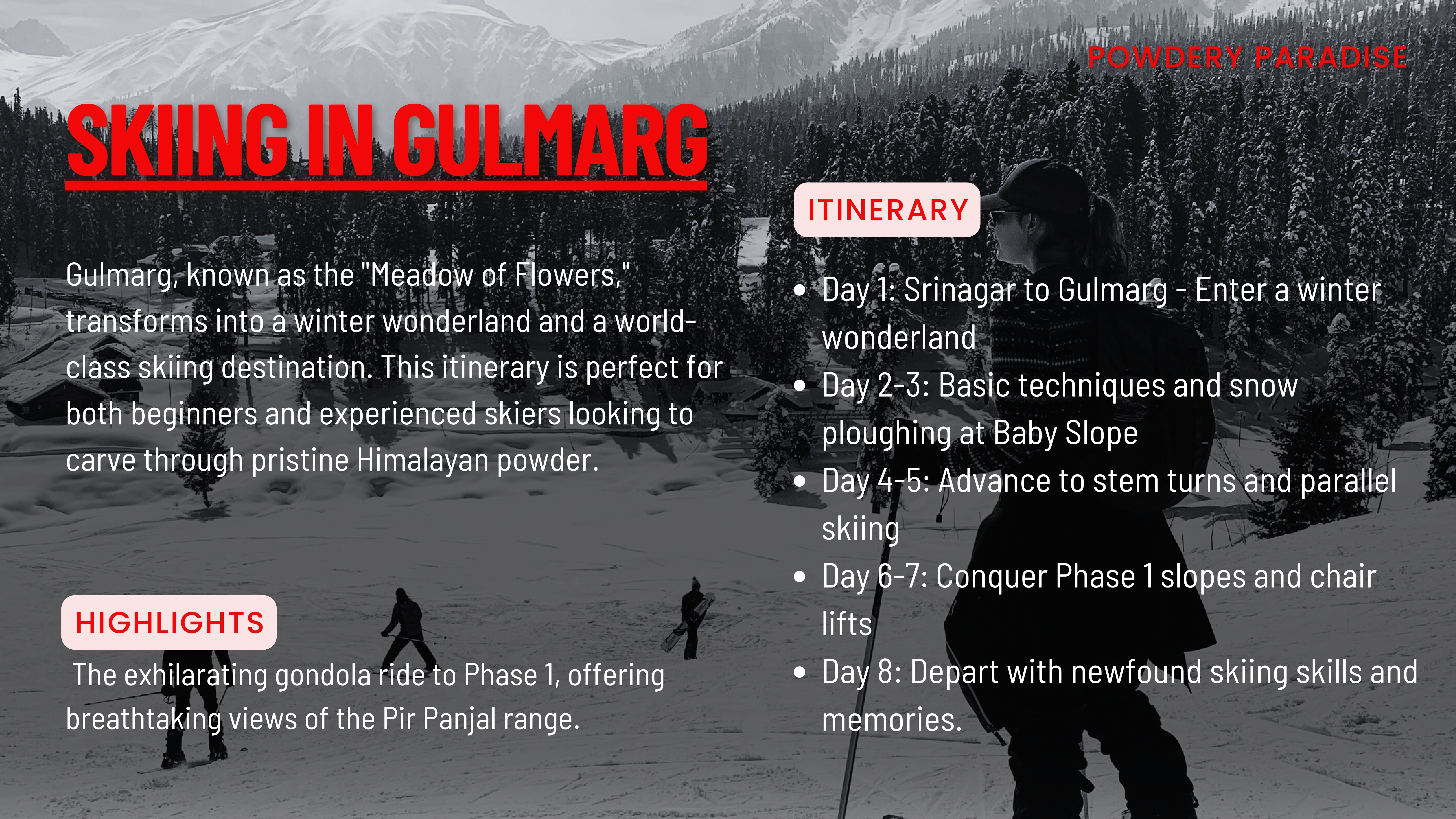
Gulmarg, known as the “Meadow of Flowers,” transforms into a winter wonderland and a world-class skiing destination. This Skiing in gulmarg itinerary is perfect for both beginners and experienced skiers looking to carve through pristine Himalayan powder.
Itinerary
-
Day 1: Srinagar to Gulmarg — Enter a winter wonderland
-
Day 2–3: Basic techniques and snow ploughing at Baby Slope
-
Day 4–5: Advance to stem turns and parallel skiing
-
Day 6–7: Conquer Phase 1 slopes and chair lifts
-
Day 8: Depart with newfound skiing skills and memories
💡 Highlight: The exhilarating gondola ride to Phase 1, offering breathtaking views of the Pir Panjal range.
Chadar Trek: Walking on Frozen Dreams
 Chadar Trek
Chadar Trek
The Chadar trek, or “The Frozen River Expedition,” is one of the most unique and challenging treks in the world. Walk on the frozen Zanskar River surrounded by towering canyon walls in this once-in-a-lifetime adventure.
Brief Itinerary
-
Day 1–3: Arrive and acclimatize in Leh (3,500 m)
-
Day 4: Leh to Shingra Koma via Bakula — Begin the frozen journey
-
Day 5: Shingra Koma to Tibb — Navigate the icy path
-
Day 6: Tibb to Nerak — Reach the trek’s midpoint
-
Day 7: Nerak to Tibb — Return journey begins
-
Day 8: Tibb to Bakula and drive to Leh — Complete the frozen expedition
-
Day 9: Departure from Leh — Bid farewell to the land of high passes
💡 Highlight: The surreal experience of walking on the frozen Zanskar River, with ever-changing ice formations and frozen waterfalls.
Nag Tibba Trek: The Serpent’s Peak
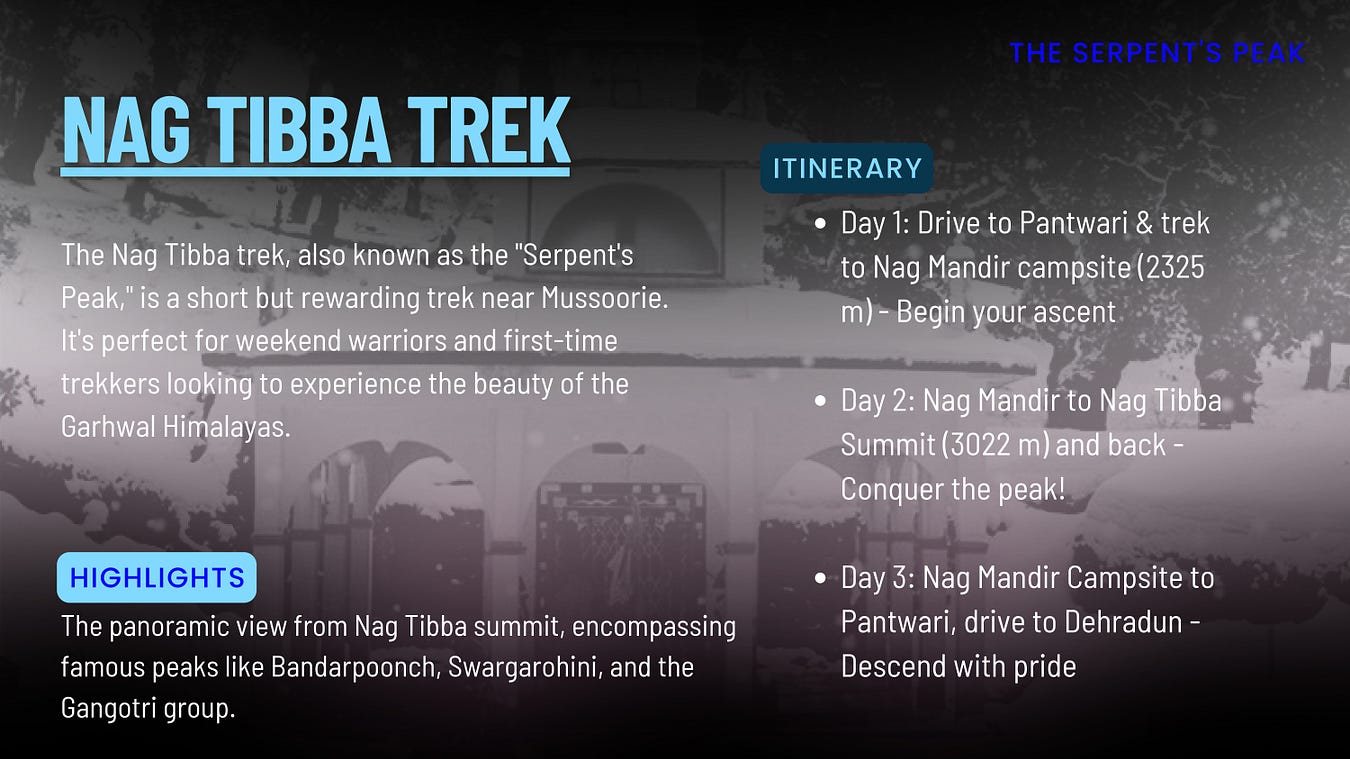 Nag Tibba Trek
Nag Tibba Trek
The Nag Tibba trek, also known as the “Serpent’s Peak,” is a short but rewarding trek near Mussoorie. It’s perfect for weekend warriors and first-time trekkers looking to experience the beauty of the Garhwal Himalayas.
Itinerary
-
Day 1: Drive to Pantwari & trek to Nag Mandir campsite (2325 m) — Begin your ascent
-
Day 2: Nag Mandir to Nag Tibba Summit (3022 m) and back — Conquer the peak!
-
Day 3: Nag Mandir Campsite to Pantwari, drive to Dehradun — Descend with pride
💡 Highlight: The panoramic view from Nag Tibba summit, encompassing famous peaks like Bandarpoonch, Swargarohini, and the Gangotri group.
Har Ki Dun Trek: Valley of the Gods
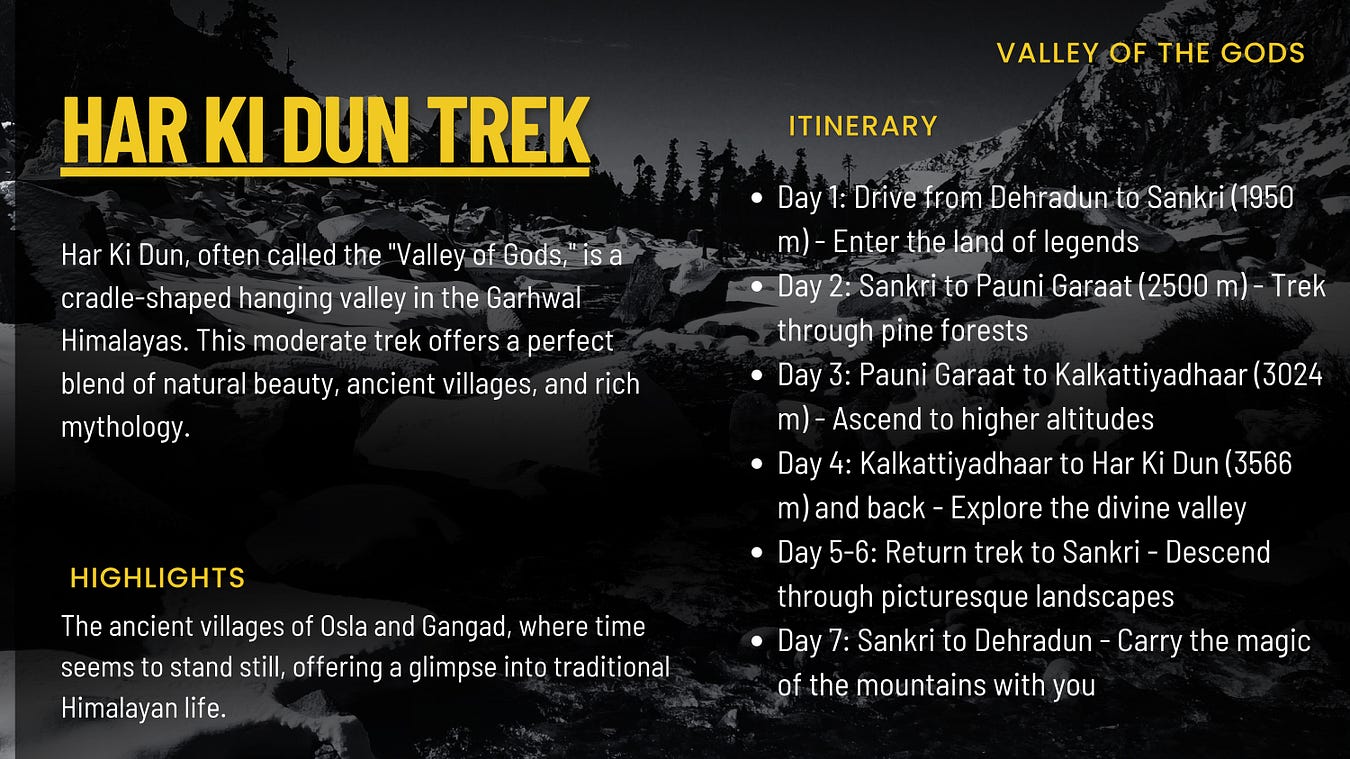 Har Ki Dun Trek
Har Ki Dun Trek
Har Ki Dun Trek, often called the “Valley of Gods,” is a cradle-shaped hanging valley in the Garhwal Himalayas. This moderate trek offers a perfect blend of natural beauty, ancient villages, and rich mythology.
Itinerary
-
Day 1: Drive from Dehradun to Sankri (1950 m) — Enter the land of legends
-
Day 2: Sankri to Pauni Garaat (2500 m) — Trek through pine forests
-
Day 3: Pauni Garaat to Kalkattiyadhaar (3024 m) — Ascend to higher altitudes
-
Day 4: Kalkattiyadhaar to Har Ki Dun (3566 m) and back — Explore the divine valley
-
Day 5–6: Return trek to Sankri — Descend through picturesque landscapes
-
Day 7: Sankri to Dehradun — Carry the magic of the mountains with you
💡 Highlight: The ancient villages of Osla and Gangad, where time seems to stand still, offering a glimpse into traditional Himalayan life.
Conclusion
Each of these treks offers a unique window into the breathtaking beauty and rich culture of the Himalayas. Whether you’re seeking challenging adventures, serene landscapes, or spiritual experiences, these journeys promise memories that will last a lifetime. Remember to trek responsibly, respect local cultures, and leave no trace. The mountains are calling — are you ready to answer?
Happy trekking!
